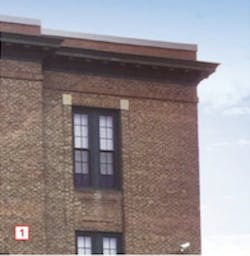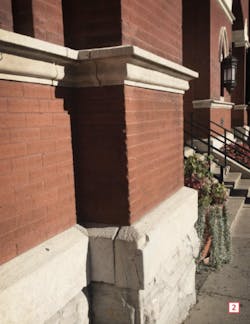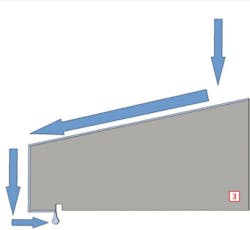Imagine you’re standing on a street corner in an old city like Boston, New York, San Francisco, or Chicago. If you look around at the old brick, stone, and terra-cotta buildings, you’ll see a lot of architectural features that break up the façade and shed water away from the building.
Starting at the top and working down, you may see a lovely cornice, which is an overhanging projection. In the late 1800s and early 1900s, it was decorative, but it also served theThese projections cantilever away from the main vertical wall face anywhere from 6 to 12 inches to as much as 3 or 4 feet [1].
If there wasn’t enough money or creative effort to put into a cornice, you would often see a capstone detail at the top of the building. A capstone is a very durable stone that can withstand the elements better than the brick masonry below it. Capstones bear the brunt of the weather and prevent water from seeping into the brick.
Capstones often have a drip edge or a drip kerf in them that helps break the surface tension of water and shed water away from the wall. (More about this below.)
Farther down the building, as we take our journey from the top to the bottom, you’ll often see continuous horizontal bands of stone or sheet metal . Like sloped window sills, which help to drain water away from the wall below, these projections capture water that’s sheeting down the face of the building and direct it away from the walls. Again, a drip edge or drip kerf plays an important role.
At the bottom of the building, particularly if the building is brick masonry or a soft sandstone, you’ll see a band of stone that’s 2 to 3 feet, maybe even 4 feet tall, off the sidewalk orAnd, even if water does wick into that water table through capillarity or just water absorption, the more durable stones can withstand the freeze-thaw cycling that tends to tear apart softer materials.
From the top to the bottom, then, the goals of architectural projections are to:
- Shed water away from the building.
- Break up the façade.
- Protect vulnerable materials with more durable materials.
Outsmarting Gravity
So how does all of this apply to everyday home remodeling? A windowsill is a good example of a functional architectural projection. The sill is typically a fairly substantial piece of wood (or stone, in a masonry wall) that the window sits on. The sill should project out from the face of the wall below by at least an inch, but 2 inches is better (even more on really big windows). The sill is sloped down and away from the window so that any water running down the glass drains away from the building.
How much slope? More is better, but window sills are commonly sloped at least ½ inch per foot or about 2.5 degrees. (A bit more slope is better at a top cornice or capstone because they take the brunt of the weather.)
But the sill also needs a drip kerf on the underside [3]. That’s because the surface tension or “clinginess” of water molecules causes water rolling down the sill and over the edge onto the vertical face to roll horizontally or even uphill along the underside of the sill. It’s one of nature’s greatest gravity-defying acts.
The kerf interrupts this flow, causing the water to form droplets that, when they get big enough to overcome the surface tension, fall off the sill. The same thing happens with a cornice or any horizontal band detail, so long as it has a kerf to break the surface tension. The drip edge on metal flashing acts is a similar water-shedding way. Wind may still blow some water back against the wall, but less water comes into contact with the wall, so the amount of staining or deterioration will be reduced.
Find more Building Science here
About the Author
Sarah Gray
Sarah Gray (M.Sc., P.Eng., CAHP) is an engineer with RDH Building Science, in Toronto. She and other engineers from RDH engage in conversations about building science and simple principles of physics that remodelers and builders can use to outsmart Mother Nature. This article is adapted from “Architectural Projections” in the “7 Minutes of BS” building science podcast series produced by Dan Morrison for ProTradeCraft.com



